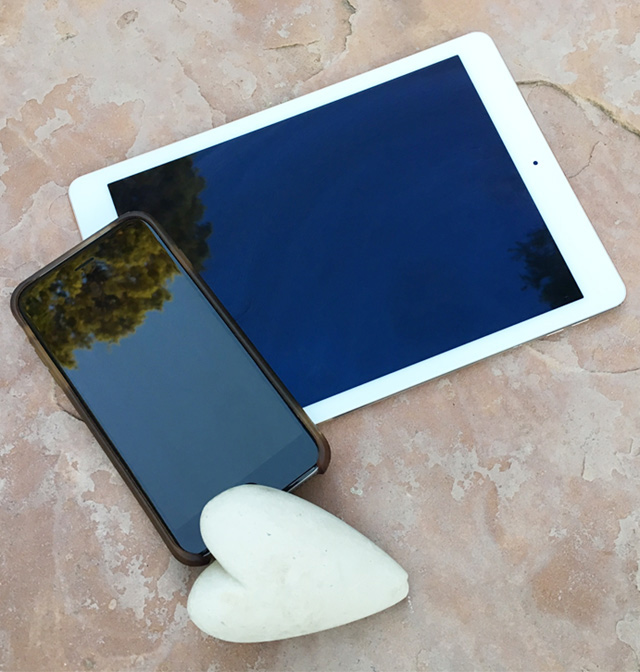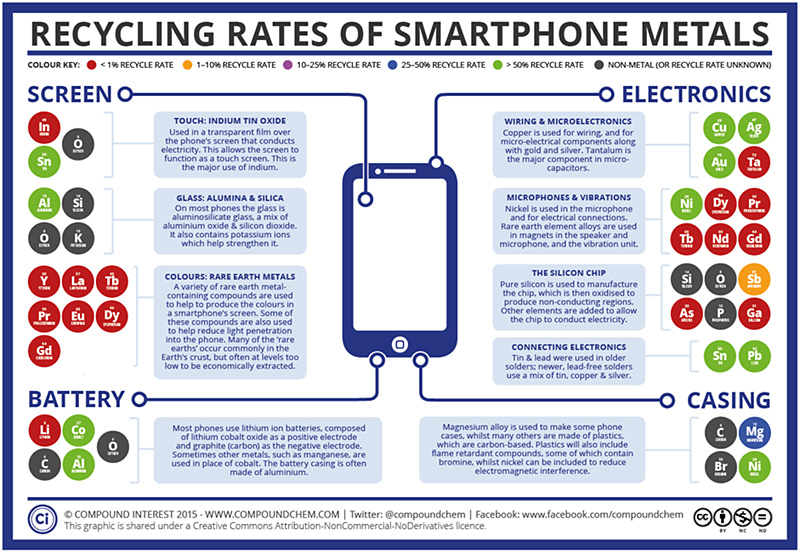
Credit: Juli Hennings, UT-Austin Bureau of Economic Geology
Remember the periodic table from high school? Neither do I! But about three-quarters of the elements are inside your smartphone, from minerals mined all over the world.
The glass on the front is a special hardened type. It’s made of quartz, which may have come from the USA, and aluminum, which probably came from Australia. It’s then treated with potassium salts, likely from Canada.
For scratch resistance, it’s given a coating, made of iridium from South Korea and tin from Indonesia.
The colors on its screen come from rare earth elements, mostly from China.
Its microelectronics could include copper from Chile, silver from Mexico, platinum from South Africa, and tungsten from Russia. Its tiny capacitors use tantalum from central Africa or Brazil.
Your phone’s rechargeable battery is made of lithium, which may have come from Argentina; cobalt from the Congo or Zambia; and pure graphite from India.
Petroleum, from many sources around the world, is used to ship all these minerals to factories, where they’re assembled into parts, then shipped again to be assembled into phones.
If supplies of any of these elements, from any of these countries, were to be restricted, it could disrupt the price and availability of the phones that billions of us rely on. There are also serious environmental impacts to mining these minerals.
Recycling the billions of old phones will ensure we have materials available for new ones.
Background
Synopsis: Smartphones and tablets have changed the way we live, work, and play since they arrived on the scene a decade ago. But it takes a whole globe to source the many compounds needed to build a modern mobile device.
- Our smartphones contain dozens of composites, compounds, and metals that include almost 75% of the elements from the periodic table.
- Each of the elements is indispensable—without them we wouldn’t be able to snap, talk, listen, record, view, pinch, swipe, or share with our connected world.
- These elements come from mineral deposits mined in nearly 20 countries all over the world. Smartphones are truly global devices!
- The amazing touch screen
- Touch-screen glass is a special mixture of aluminum oxide and quartz (silicon dioxide), which comes from the United States or China. The aluminum ore is bauxite, supplied mainly by Australia and China.
- The glass is placed in a hot bath of molten salt, allowing potassium ions to replace smaller sodium ions to increase the compressive strength of the glass after it cools. The potassium salt is sylvite from Canada, Russia, or Belarus.
- Then an ultrathin conductive layer of clear iridium tin oxide is deposited on the glass so you can touch the screen without damaging it. The iridium comes from sphalerite from China or South Korea, and the tin is derived from cassiterite from China, Indonesia, or Peru.
- The light-emitting-diode (LED) screen backlighting comes from gallium, which is also refined from bauxite.
- Rare earth elements from China provide blue, green, red, and yellow phosphors for the color displays on the screen.
- The circuitry that makes it all happen
- The chip—the processor in your smartphone—is made of pure silicon that is coated with silicon dioxide, both derived from quartz. The parts of this silicon dioxide layer where current will be required to flow are then removed. Chip technology is changing rapidly to utilize other elements that will enable more miniaturization.
- Micro-electrical components and wiring in the phone are composed mainly of copper (Chile, China), gold (China, Australia), and silver (Mexico, China). Platinum (South Africa, Russia), palladium (Russia, South Africa), and tungsten (China, Russia) are used in the circuitry.
- Tantalum, the main component of microcapacitors, is rare, with supplies limited to the Congo, Rwanda, and Brazil.
- The microphone, speaker, and vibrator of the phone contain rare-earth-element magnets from China.
- The amplifiers use gallium arsenide from bauxite (Australia, China) and arsenopyrite (China, Morocco).
- The lightweight rechargeable battery
- Most of today’s mobile devices use lithium iron batteries—usually housed in an aluminum casing—because they are light and recharge pretty quickly.
- Usually these batteries use lithium cobalt oxide for the positive electrode, but sometimes other transition metals are used in place of cobalt. Half of the world’s cobalt comes from the Congo, and recent concerns have developed about child labor and “conflict” cobalt from this source. Australia, China, Russia, and Zambia are other sources. Lithium comes from Australia, Chile, Argentina, and China.
- The battery’s negative electrode is made from pure carbon graphite, from metamorphism of organic-rich sediments found in the mountains of China and India.
- The protective case
- Cases are made from a variety of lightweight metals and plastics; the most common are aluminum alloys sourced from bauxite ore.
- Even plastics come from the earth: they are products of crude-oil refining. Plastic cases allow signal reception, are flexible and damage resistant, and can stand up to temperature fluctuations.

Leading countries producing minerals for smartphones and other mobile devices.
Credit: USGS public domain
- A mineral-supply cut-off from any of these countries could disrupt the supply of smartphones and tablets to the billions of consumers who rely on them. For example, China is the only known source for about 97% of the rare earth elements used in smartphones, which come from minerals like bastnaesite, monazite, and xenotime.
- These rare earth elements are essential for making the screen glass harder, for the colors we see in the display, and as magnets in headphones and speakers.
- If China decreases supply and raises the price for manufacturers, the price of the devices goes up for everyone.
- Materials scientists are developing innovative new products, and mineral explorers are looking for additional sources of rare earth elements to keep our world connected into the future, but the best resource we have is recycling the materials directly from our existing smartphones.
- Don’t put your smartphones in the trash! Millions are discarded every year, and we need those elements for the future!
- The EPA provides a listing of recycling centers for phones (see References below).


